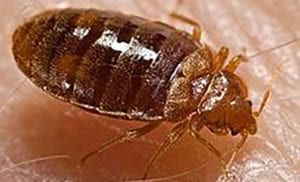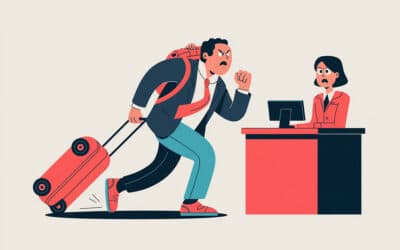There are few things worse than bedbugs while you’re traveling. Steering clear of bedbugs while traveling and preventing them from hitching a ride with you when returning home is essential.

If you’re curious who topped the list, it’s Chicago. If you’re thinking that population alone puts a city near the top of the list, it’s not true. While Los Angeles is fourth, New York is 15th, Houston is 45th, Phoenix isn’t in the top 50 and Philadelphia is 25th.
While bedbug bites might not be dangerous, the out-of-this-world itching and excessive scratching they cause can lead to infection.
The CDC (Centers for Disease Control and Prevention) states that bedbugs aren’t considered to be dangerous or spread disease, but some people have allergic reactions to their bites that require medical attention. For most people, bedbug bites are beyond annoying! The bites cause itching and sleep loss. For many, the itching can lead to excessive scratching that can become infected. I know many people whose vacations were ruined by bedbug bites and subsequent infections.
Bed bugs are small, flat, reddish-brown, wingless, parasitic insects. They’re about half the size of a U.S. Lincoln penny. They feed on the blood of people and animals when asleep.

Possibly worse than being bitten by bedbugs is when travelers let them hitch a ride in their luggage or clothes and they then infest their home.
Possibly worse than being bitten by bedbugs while away from home is when travelers find that bedbugs have hitched a ride in their luggage and/or clothing, then infested their home. Travelers must do their best to prevent bedbugs from coming with them when returning home. Bedbug infestations are a challenge to remove. They require a professional bedbug cleaning service that may have to fumigate. According to professionals in my home region, bedbug extermination can cost between $1,000 and $6,000, depending on the severity and size of the infestation.
Here’s what travelers can do to avoid bedbug problems.
Before you travel:
Travelers need to learn the signs of bedbug presence. They are clues for travelers so they can avoid bedbug infestations in airports, airliners and hotels. The signs of bedbug infestation include:
- Discarded bedbugs’ exoskeletons after molting,
- Rusty–colored blood spots from bedbugs’ blood-filled fecal material excreted on the mattress, mattress pad, sheets, or nearby furniture or other surfaces,
- Bedbugs seen in the folds of upholstered furniture, mattresses and sheets, including seats on airplanes,
- A sweet musty odor in vacation rentals, AirBnbs and/or hotel rooms.
Choose the right luggage. Bedbugs can climb on to any surface. They like to hide in cracks and crevices, the deeper the better, because light can’t shine into deep ones. Hard-sided luggage, as opposed to fabric-sided luggage, will tend to not allow bedbugs to attach themselves to your luggage.
At the airport:
It’s less likely that bedbugs will be hanging around in brightly lit areas at airports. Choose seating that isn’t upholstered, if possible. Upholstered furniture is more likely to hide bedbugs in its crevices.
On your flights:
The likely spots for bedbugs on your plane flight are in the seats and the overhead bins. You can look in your seat crevices with a flashlight if you’re concerned. In the overhead bin, look for stains or little reddish-brown dots, especially in the overhead bin’s corners.
At your hotel, vacation rental, AirBnB:
Inspect your hotel room, vacation rental or AirBnB upon arrival:
• Immediately after you arrive, place your belongings in a safe place. For me that’s the bathroom, where bedbugs can’t hide. My bags go directly into the bathtub or if none, the shower.
Tip: Bring a small, bright LED flashlight to help you inspect your room.
• Inspect the beds and bed linen in your room carefully. Strip the bed of all linen and the mattress pad. Examine the mattress carefully, and box spring if any. Use a flashlight to examine the bed frame as well as possible. Carefully check all bed linens and pads for tell-tale signs of bedbug presence. Then check all upholstered furniture in your room. Check the closets, too.
When you find bedbugs, move out fast. Get another hotel room or hotel. At an Airbnb or vacation rental, report the problem immediately and try to move out. Make a paper record of your communication about the problem to prove you’ve followed the rules and are owed a refund.
If you find bedbugs, move to another room at least two floors away, if not another hotel. If at a vacation property or AirBnB, call the correct number to report property problems and try to move to another property. You need to immediately start a paper trail too. Send an email (text messages are too easily deleted or manipulated). Never depend on phone calls. You need communication proof!
If your room or property looks good, take precautions anyway, as bedbugs are adept at hiding and in hotels can travel from an infested room to one not initially infested:
- Keep your luggage off the floor. Use a luggage rack (after you inspect it), desktop, top of a chest or dresser, or an unupholstered chair or bench.
- Keep your belongings in your luggage. Don’t use the dresser or other drawers in your room.
- If you are traveling with young children, make sure that stuffed animals stay off the floor and are stowed in plastic bags with your luggage when you’re out of the room.
- Keep your soiled laundry off the floor, even when they’re in a laundry bag. Don’t use cloth laundry bags. According to a study by William T. Hentley, Ben Webster, Sophie E.F. Evison and Michael T. Siva-Jothy, published in Springer Nature, bedbugs are twice as likely to aggregate on bags containing soiled clothes than clean ones. Stow your soiled laundry in a sealed plastic bag.
When you get home:
If you have any suspicions that you’ve brought home bedbugs from your journey, immediately unpack your clothes directly into your dryer, not the washer. Put the clothes you wore home in the dryer too. You can wash them after running them through a dryer cycle. Because the hot water at home is not hot enough to kill bedbugs, you need to put them in the dryer on high for 30 minutes. For clothes that need dry cleaning, put them in a sealed plastic bag and get them cleaned as soon as possible.
You can encounter bedbugs on any journey. Be aware of the possibility and take the above listed actions to minimize your potential contact with them.

READ ALSO:
Travelers are worried about car rental safety. Here’s how to avoid a problem
DOT is creating anti-consumer rules through inaction
After many years working in corporate America as a chemical engineer, executive and eventually CFO of a multinational manufacturer, Ned founded a tech consulting company and later restarted NSL Photography, his photography business. Before entering the corporate world, Ned worked as a Public Health Engineer for the Philadelphia Department of Public Health. As a well known corporate, travel and wildlife photographer, Ned travels the world writing about travel and photography, as well as running photography workshops, seminars and photowalks. Visit Ned’s Photography Blog and Galleries.



